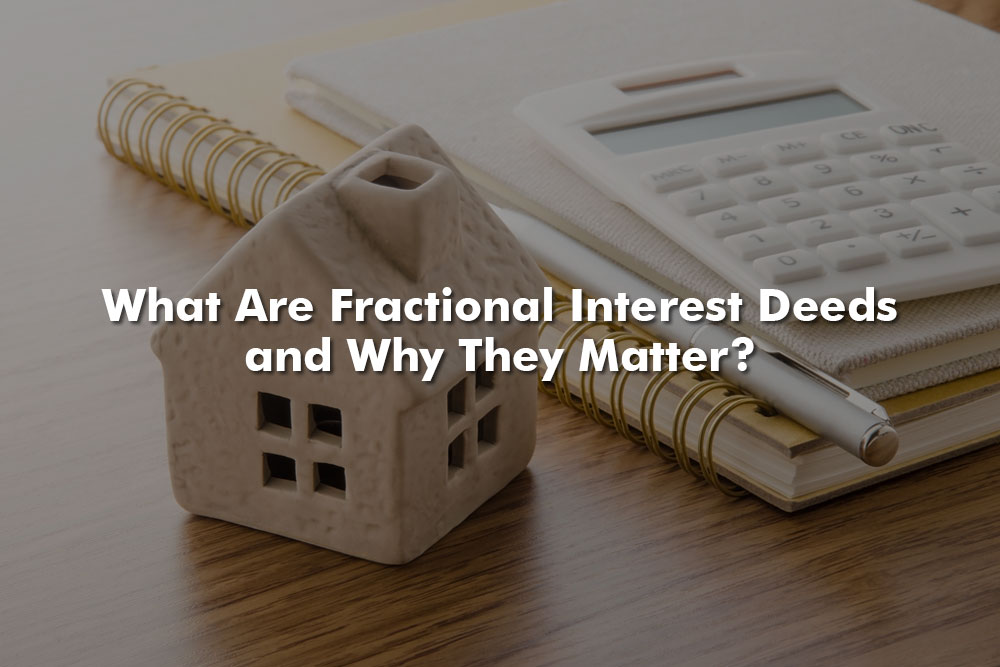What Are Fractional Interest Deeds?
A fractional interest deed is a legal document that grants ownership of a percentage of a property to one or more individuals. Unlike traditional sole ownership, fractional interest deeds divide ownership among multiple parties, each holding a specific share in the property.
Fractional ownership is common in real estate transactions involving family inheritances, business partnerships, and investment properties. These deeds outline each party’s rights, responsibilities, and share of the property’s value, ensuring clarity in ownership.
Types of Fractional Interest Ownership
There are several ways to structure fractional interest ownership, each with distinct legal and financial implications:
1. Tenancy in Common (TIC)
- Each owner holds an undivided percentage interest in the property.
- Ownership percentages can be equal or different among the co-owners.
- Owners can sell or transfer their shares independently.
- If one owner passes away, their share passes to their heirs, not the other owners.
2. Joint Tenancy with Right of Survivorship
- Each owner holds an equal share in the property.
- If one owner dies, their share automatically transfers to the surviving owners.
- This structure avoids probate and simplifies asset transfer but does not allow individual share transfers without breaking the joint tenancy.
3. Community Property (for Married Couples in Certain States)
- Both spouses share equal ownership in the property.
- Upon the death of one spouse, the surviving spouse automatically receives full ownership.
- Provides tax benefits by adjusting the property’s cost basis upon the first spouse’s death.
Why Fractional Interest Deeds Matter
Fractional interest deeds are essential for a variety of legal and financial reasons. Here’s why they matter:
1. Facilitating Shared Ownership
- Allows multiple individuals to co-own property while defining clear ownership rights.
- Useful for family inheritances, business partnerships, and real estate investment groups.
2. Estate Planning Benefits
- Helps distribute property among heirs without requiring probate.
- Can be structured to minimize estate tax burdens.
- Ensures a smooth transfer of ownership among family members.
3. Flexibility in Property Transactions
- Owners can sell, gift, or transfer their shares independently, depending on the ownership structure.
- Can be used to bring in new investors or business partners without selling the entire property.
4. Tax Considerations
- Owners are responsible for property taxes based on their ownership percentage.
- Transfer of ownership through fractional interest deeds may trigger capital gains tax or property reassessment.
- Can be structured to take advantage of tax deferral strategies like 1031 exchanges.
5. Asset Protection
- Properly structured fractional ownership can shield assets from creditors.
- Protects an owner’s share from personal financial liabilities unrelated to the property.
Challenges of Fractional Interest Deeds
While fractional ownership has advantages, it also presents potential challenges:
- Disputes Among Co-Owners: Differing opinions on property management can lead to conflicts.
- Difficulty in Selling Shares: Some ownership structures limit an individual’s ability to sell or transfer their share.
- Legal and Tax Complexities: Proper legal documentation is essential to avoid unintended tax liabilities and legal disputes.
How to Set Up a Fractional Interest Deed
Setting up a fractional interest deed requires careful planning and legal documentation. Here’s how it’s done:
- Consult an Estate Planning or Real Estate Attorney
- A lawyer can ensure the deed aligns with your financial and legal goals.
- Determine Ownership Structure
- Decide whether ownership will be structured as a Tenancy in Common, Joint Tenancy, or another form.
- Draft the Fractional Interest Deed
- Clearly define ownership percentages, rights, and responsibilities.
- Include provisions for future sales, transfers, and dispute resolution.
- File the Deed with the County Recorder’s Office
- The deed must be legally recorded to establish ownership rights.
- Update Estate Planning Documents
- Ensure that wills, trusts, and beneficiary designations reflect fractional property interests.
How We Can Help
Fractional interest deeds can be an effective tool for estate planning and property ownership, but they require careful legal structuring. At Allenby Law, we help clients navigate the complexities of real estate and estate planning to ensure a smooth and secure property transfer. Whether you need to establish a fractional interest deed, manage co-ownership disputes, or optimize tax strategies, our team is here to guide you. Contact us today to discuss how we can simplify your estate planning and real estate transactions.



